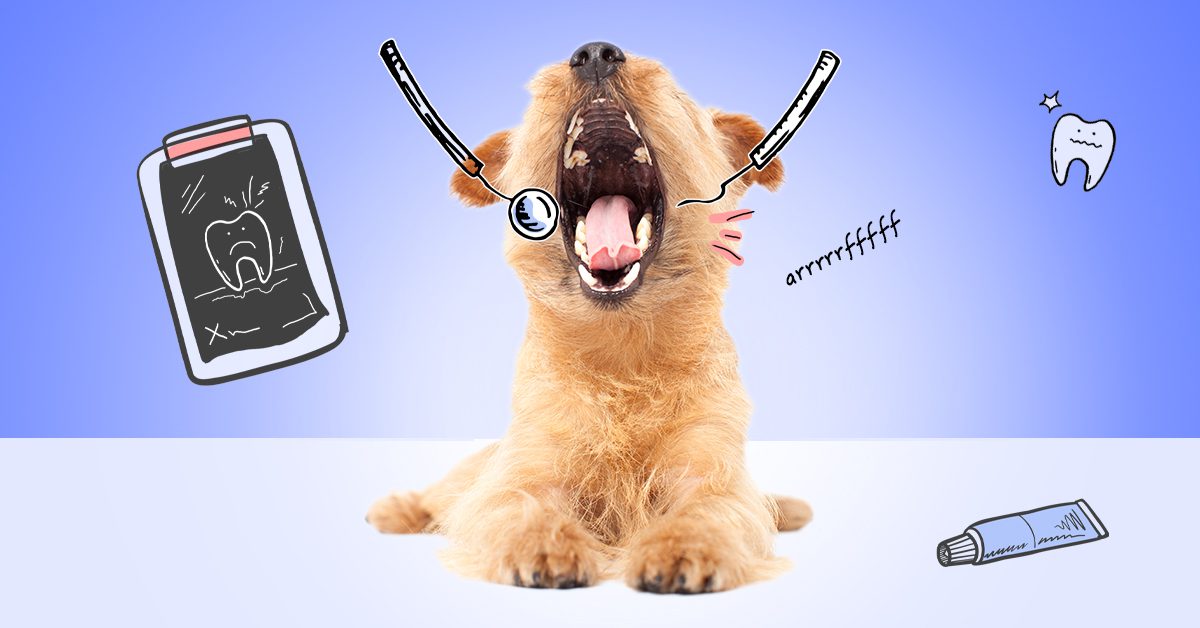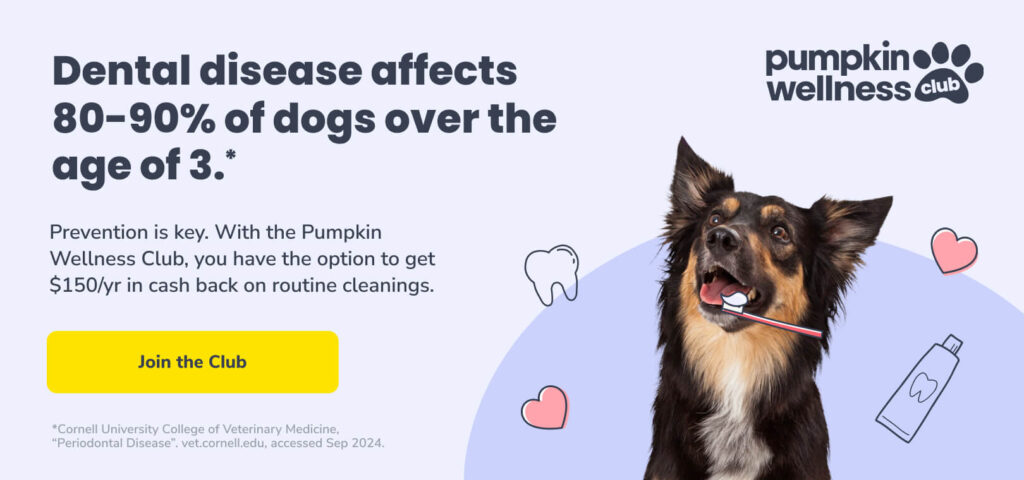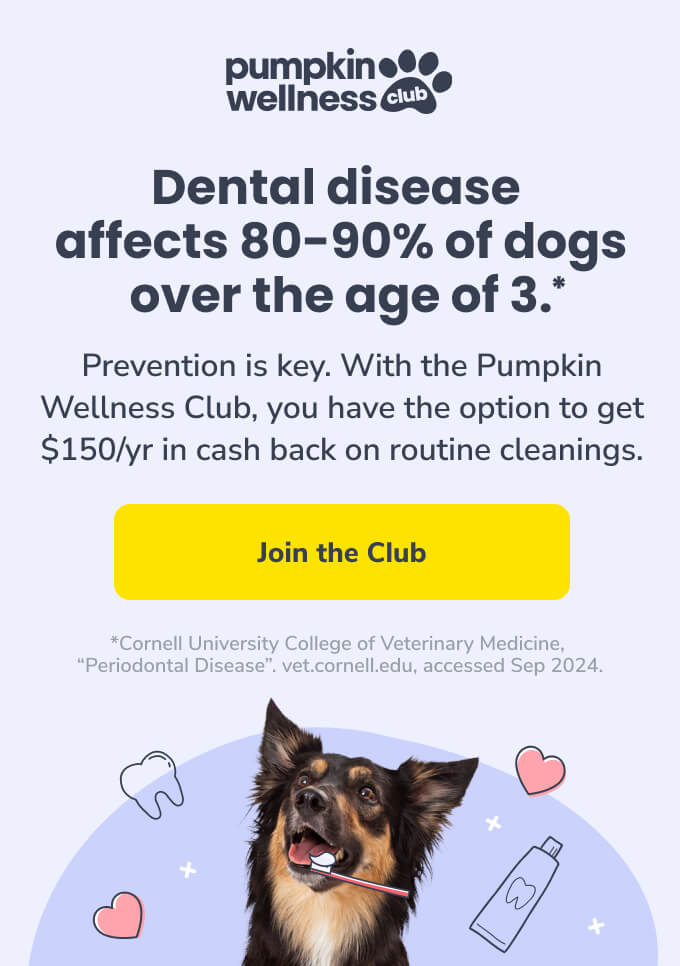Key Points:
- Dogs need regular dental care — both at home and from a veterinarian — to protect against gum disease.
- Small and toy breeds with tiny mouths are especially susceptible to dental disease.
- Members of the Pumpkin Wellness Club* have the option to get up to $150 in cash for yearly doggie dental cleanings, plus more savings on routine care and access to special discounts on top pet brands.
Dental health is just as important for our tail-waggers as it is for us. We wouldn’t go a day without brushing and flossing our teeth, and your dog needs a regular dental routine as well.
Studies show that 80-90% of dogs over the age of three display some sign of dental disease. If teeth aren’t maintained properly, plaque and tartar will build up causing infection and gingivitis (bleeding gums), which leads to periodontal disease.
When periodontal disease is present, the harmful bacteria produced in your dog’s mouth will enter the bloodstream and can gradually damage the heart, kidneys, and liver. This is especially true for small and toy breeds. They have tiny mouths, making them especially susceptible to dental disease.
A regular dental hygiene routine at home and dental check-ups with your veterinarian every 6-12 months can extend the happiness and life span of your dog. Not all pet owners know this — in fact, an Ipsos study shows 95% of dog owners brush their own teeth regularly, but only 7% of them regularly brush their dog’s teeth.
If you’re part of that 7%, don’t worry: It’s not too late to start looking after your dog’s dental health. Brushing your dog’s teeth might sound challenging, but it doesn’t have to be. We’re here with tips and tricks for making home dental care easy — plus, Pumpkin can help you plan ahead and save on your dog’s dental check-ups.
Pet Pro Tip: New to doggie dental care? Join the Pumpkin Wellness Club, a new program designed to help you pay for the routine preventive care your pup needs to stay healthy. Membership options include a plan that pays you up to $150 in cash for dental cleanings each year, and all members get access to a 24/7 Pet Health Helpline and special discounts on top pet brands.
Causes of dental disease in dogs
Dental disease is painful, and many dog owners never realize their dog is suffering until it’s advanced enough to cause additional problems. It’s not your fault — your dog can’t tell you they have a toothache, so you might not notice that your dog is in pain.
There are five stages to periodontal disease. The common signs are:
- Broken teeth and roots
- Gingivitis
- Periodontal disease
- Tooth root abscesses and other infections of the mouth
- Misalignment of the teeth or jaw
- Cysts or tumors in the mouth
Unlike human spit, dog saliva doesn’t contain enzymes to fight bacteria. Without that bathing capacity to clean the mouth, the food sits on the gums and in between the teeth. Plaque develops on the teeth, creating the perfect conditions for dental disease.
Many pet owners believe that kibble will clean a dog’s teeth. This is only helpful to the point that the crunchy kibble actually provides friction to the surface of the teeth.
“A dog’s upper teeth overlap their bottom teeth, so the chewing surface (and only the chewing surface) benefits from friction when they chew on kibble or crunchy things … They take no friction on the outside surface of their teeth — which is where my technicians spend more than 90% of their time scaling and scraping plaque from during cleanings.”
Dr. Ryan Gates, DVM, Cuyahoga Falls Veterinary Clinic
Without removing the plaque, it hardens into a calcium-like substance called tartar or dental calculus. We get it on our own teeth too, and need regular cleanings to have it scaled off. In the absence of dental care, after a time, tartar accumulates around the base of the tooth and irritates the gums.
The same is true for dogs. Tartar buildup can create pockets in the gumline, giving the bacteria an opportunity to develop into an abscess or infection. At this stage of periodontal disease, you may notice your dog’s breath is especially smelly and their gums may be red.
As periodontal disease progresses, the bacteria in your dog’s gums can enter their bloodstream and affect the heart, liver, and kidneys. Advanced periodontal disease can also invade bones, putting your dog at risk for jaw bone fractures.
Signs of dental disease in dogs
Dental disease is painful, and many dog owners never realize their dog is suffering until it’s advanced enough to cause additional problems. It’s not your fault — your dog can’t tell you they have a toothache, so you might not notice that your dog is in pain.
There are five stages to periodontal disease. The common signs are:
- Bad breath
- Bloody or swollen, inflamed gums
- Broken or discolored teeth
- Tartar buildup on the teeth and gumline
- Abnormal chewing
- Drooling (sometimes bloody) or dropping food from the mouth
- Sneezing or nasal discharge (dental disease on upper teeth can destroy the bone and invade the nasal cavity)
- Decreased appetite or refusal to eat
- Bleeding from the mouth or gums
- Pain around or inside the mouth
- Swelling around or inside the mouth
All of these symptoms indicate the need for a dental evaluation with your vet ASAP. Luckily, you can lower your dog’s risk of periodontal disease with routine dental care.
The cost of dental care for dogs
Dental care can be expensive, and most dog parents quake at the thought of it. Where you live; the size, age, and health of your dog; and the extent of medical treatment needed are all factors when determining the cost of dentistry for dogs.
Depending on your dog’s age, the cost of a cleaning could run between $400 and $1,000. This includes the cleaning, bloodwork, x-rays, and general anesthesia. Most veterinary professionals and institutions urge pet owners to avoid anesthesia-free dentistry, as anesthesia is necessary to perform safe and effective diagnostics.
A more severe case of dental disease may involve a canine dental specialist and could require tooth extraction or gum excising. This can run up to $5,000.
“Preventive cleanings are less costly and are more likely to preserve your dog’s teeth than cleaning up severe gum infection in the mouth and addressing the diminished quality of life that results from ignoring dental health for a long time.”
Dr. Ryan Gates, DVM, Cuyahoga Falls Veterinary Clinic
Even with good dental hygiene, some breeds are predisposed to dental issues and may still develop dental disease as they age. Pet insurance for accidents and illnesses can help you prepare for the cost of care before your dog gets sick. This coverage can help make it easier to choose consistent dental care for your dog’s health without breaking the bank.
As for routine dental care, Pumpkin Wellness Club can help with that. Members can plan ahead for preventive dental care by selecting a plan that gives you up to $150 in cash for your pet’s yearly dental cleanings. The Pumpkin Wellness Club also pays you for several other preventive care services, like vaccines and health screenings, and offers discounts on top pet products to help you save on the best possible care.
Preventing dental disease in dogs
A dog’s risk of dental disease only increases with age. So, the earlier you get started with routine dental cleanings and brushings (the gold standard), the better it will be for your dog.
Fortunately, good dental health isn’t difficult to accomplish. Let’s look at the best ways to prevent dental disease for your pooch.
Three steps to prevent dental disease:
The dental checkup
Your dog should have an official dental exam every 12-24 months, depending on your veterinarian’s recommendation and your dog’s individual needs.
Initially, your vet will do a physical exam of your dog’s mouth. This gives them a window into the condition of your pup’s teeth and jaw. Here’s what they will look for:
- How the teeth fit together and the jaw aligns (missing or extra teeth, an overbite, or an under-bite).
- Fractured, or broken teeth
- Gingivitis or periodontal disease
- A buildup of tartar on the teeth and along the gumline
- Abscesses or signs of infection
- Bumps or lesions that may indicate a tumor
- Any facial swelling
Depending on the results of the physical exam, your veterinarian will develop a plan for your dog or schedule a more thorough examination.
A note on high-risk breeds:
Small and brachycephalic (flat noses like bulldogs and Pekinese) breeds should have dental exams every six months. Their teeth have shallow roots and are typically overcrowded, making them more likely to develop dental disease or tooth problems.
“I am always amazed when cleaning a small breed’s teeth, due to the overwhelming amount of tartar, calculus, and disease present. Years of breeding small dogs to get smaller and smaller has caused major issues within the mouth. Overcrowding of the teeth is one the main concerns as well as retained deciduous teeth (baby teeth). This is why we recommend that most small breeds get their first dental cleaning at 6- 12 months of age.”
Michael Riffe, Vet Assistant, Harbor Veterinary Clinic
Common dental procedures
During the physical exam, only the tops of a dog’s teeth are visible. Seeing the roots and bones under the gumline is vital to assessing true dental health. The results of the physical will determine any additional dental examination or procedures your dog needs.
Some dental procedures are as simple as routine teeth cleaning. If severe dental disease is present, there may be aggressive treatments required or oral surgery.
Let’s look at what you can expect during dental procedures.
General Anesthesia
The vet will typically administer medication to calm your dog before anesthesia is used. Next, they will give a general anesthetic with oxygen supplementation to allow for proper x-rays, a thorough examination, and any procedures necessary without the concern of your dog moving or being uncomfortable.
Many times this is when they find the complete extent of any disease and the damage it caused. In fact, the American Animal Hospital Association (AAHA) determined that x-rays found that 27.8% of dogs had additional dental disease not visible to the naked eye.
If oral surgery is needed for procedures like removing tumors, excising gum tissue, or extractions for damaged or impacted teeth, your pet may be referred to a Veterinary Dental Specialist.
Routine Dental Cleaning
For routine cleaning with no dental disease, it’s very similar to when we get our teeth scaled and polished. The vet will scale tartar off of your dog’s teeth and remove plaque at the gumline with root planing. This will remove the harmful bacteria that can cause disease.
The vet will also polish your dog’s teeth and flush the mouth to remove any remaining bits of tartar or plaque. Polishing the teeth smooths out the surface, making it harder for plaque to adhere to them. Finally, the vet will check the teeth and gums with a blunt probe to assess the stage of periodontal disease. This will help them develop an ongoing dental plan for your dog.
Preventing dental disease at home
Only 7% of dog parents routinely brush their dog’s teeth. Many don’t realize the importance good nutrition and professional cleaning have on their dog’s overall health or believe it’s too hard or time-consuming. Good nutrition and professional cleanings are vital, but a home dental routine is necessary for optimal dental health.
“Nothing beats brushing your pet’s teeth at least 3-4 times for a week. The older a dog gets, the more likely dental problems will develop. And the earlier you get started with routine dental cleanings and brushings, the better it will be for your dog.”
Dr. Maritza Bruno, DVM, West Orange Animal Hospital
The good news is it’s easier than you think, even for an older dog. Most dog toothpaste is chicken- or liver-flavored (mmm, chicken). If your dog doesn’t like those flavors, you can use a dilution of salt and water — but never human toothpaste, as the fluoride in it will upset your dog’s digestive system.
Here are some steps to introduce an oral cleaning routine to your dog:
Baby steps: Start by getting your dog used to you messing with their mouth. Run your fingers over the outside of their mouths, chin, and cheeks. The whisker area is sensitive, but you want them to get used to you touching their face and mouth, so go slow if your pooch seems hesitant.
Get inside: After your dog is comfortable with step one, run your finger around their cheeks, inside the mouth, and over the gums. Using cotton gauze wrapped around your finger, or a finger brush at this point works well too.
Play can be good. Introduce the dog toothbrush by letting them mouth it. They shouldn’t chew on the bristles, but licking and mouthing it is a great way to get them comfortable with it. (If your dog isn’t tolerating the toothbrush, try using a finger brush to clean their teeth.)
Add the tasty. Once your dog is comfortable with the brush, add a dab of veterinary toothpaste or a salt and water dilution to the brush. Using small, slow circular motions, brush the outside surface of your dog’s teeth letting it slide lightly over their gums as well.
Progress, not perfection: Over the next few days, increase the number of teeth brushed. Remember to always brush in a circular motion and pay attention to the gums as well. When your dog is comfortable, brush the insides of the teeth as well.
Keep it brief. You only need a couple of minutes a day to accomplish good oral health. Using praise and healthy treats keep the sessions a positive experience.
Remember that dogs like routines — brushing at least 2-3 times per week is good, but daily is better. Use praise, reassurance, and healthy treats to signal the completion of the routine and your dog will soon look forward to having their teeth brushed.
Products, treats, and toys that support dog dental health
Dental care can be fun for your dog, too. Don’t forget to stock up on treats and toys that support your dog’s teeth and gums, and ask your vet which dental products they recommend.
Plaque-reducing dental products
Nutrition:
A healthy diet is the foundation for fighting dental disease to keep your dog’s body at its optimum health. There are also dental foods available and may be recommended by your vet.
Enzymatic dog oral rinses and water additives:
These help prevent the formation of plaque on your dog’s teeth. Some contain kelp, and some contain cheese enzymes. They raise the PH balance in your dog’s mouth and demineralize the plaque.
They can be sprinkled on top of dog food, or added to your dog’s water bowl. These are good for dental care between brushings.
Tooth wipes:
Resembling baby wipes, they do the same thing as the gauze with doggy toothpaste. If your dog doesn’t like the toothbrush, these are a good alternative.
The Veterinary Oral Health Council (VOHC) has several products they recommend for doggie dental health.
Dental bones, chews & treats
Chewing is necessary for dogs of all ages for mental stimulation and jaw exercise. It also releases endorphins that relieve stress. However, you should avoid any too-hard bones or chew sticks. These can shatter your dog’s delicate teeth, or could splinter and leave sharp edges that can cut your dog’s gums and tongue and create havoc in their gastrointestinal system if swallowed.
“Tartar starts forming on the teeth immediately after a teeth cleaning, so having annual teeth cleanings along with at home care products such as Veggiedent Treats, which we promote at our clinic, can significantly help keep severe dental disease at bay.”
Michael Riffe, Harbor Veterinary Clinic
Greenies are another good choice for teeth-cleaning treats. They’re considered an abrasive for removing plaque during the chewing process. They are high in calories also, making moderation important.
Dental toys
Dental toys are beneficial, especially for more aggressive chewers who can go through a bully stick in minutes. They’re a mechanical, or abrasive, tooth cleaning tool. As your dog chews them, they scrape the plaque off the tooth and massage the gums for better dental health.
Kongs, doggy tennis balls, knotted rope chews, and Nylabones are all good options for hours of chewing happiness.
The bottom line on doggie dental health
As you can see, your dog’s dental health is as important as your own. Teeth are the windows to overall health in both humans and dogs, and they need regular professional cleaning, checkups, and the right diet in order to provide a longer and healthier life for your pooch.
Your pup’s yearly exam is a great time to discuss their dental health with your veterinarian and learn what preventive care, treatments, and daily home habits they recommend. In the meantime, don’t forget to check out the Pumpkin Wellness Club and learn how you can get paid for your pet’s next routine vet visit.
DISCLOSURE






